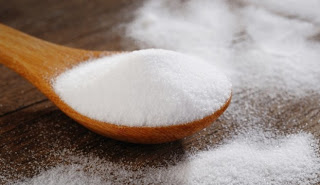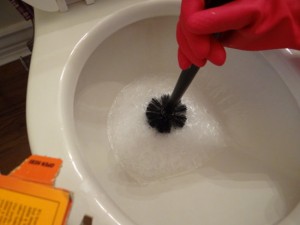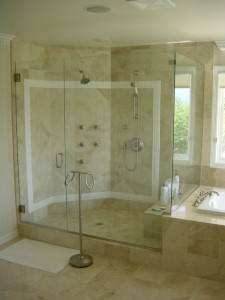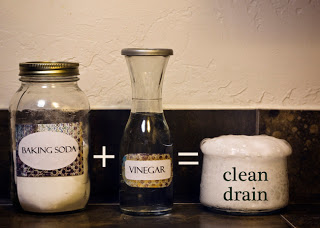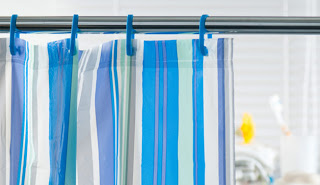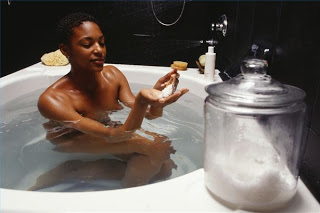Baking Soda – All The Ways You Can Use It To CLEAN Cheaply, Safely & Effectively
If you haven’t already learned the numerous ways to use baking soda to effectively and cheaply clean your home then it is about time! Baking soda, also called bicarbonate of soda or sodium bicarbonate raises cakes and calms heartburn. It also fulfills a number of cleaning applications. Although it’s mild enough to use on most household surfaces, this article focuses on uses in the bathroom — which covers a lot of ground, metaphorically speaking.
1. Cleaning the ToiletProbably not TOP ON THE LIST of favorite things to do. It can be stinky, scary, and covered in oddly shaped and darkly colored stains. So strap on some rubber gloves, breathe a hefty dose of confidence, and maybe even plug your nose and get ready to tackle the porcelain throne.
Widget not in any sidebars
You’ve probably noticed that the minerals in water, especially hard water, can stain the toilet and cause a pesky ring where the water level sits in the bowl. If allowed to build, such stains require strongly acidic cleansers to remove. These products can slowly erode the porcelain, not to mention the immediate damage they can do to the skin, eyes, nose and throat.
A simple once-a-week routine:
Sprinkle the toilet with cup of baking soda. Let it sit for 30 minutes, then spray or squirt with vinegar (a mild acid) to moisten. Scrub with a bowl brush and flush away.
2. Bathtubs and SinksWe’ve all seen the ring around the tub after taking a bath. And if you’re like most people you automatically point the finger at your partner or roommate while saying ‘eww, clean the tub, that’s disgusting!’ Did you know, that a ring around the tub isn’t necessary an indicator of poor hygiene? Hard water strikes again! The minerals present in water can discolor the porcelain and soap scum can strike! Bathtubs, showers and sinks are all prone to soap scum.
Here’s what you do:Wipe down tubs and sinks after using them to prevent soap scum from forming (this one is kind of obvious. I like to keep a designated soap scum sponge in my bathroom). If soap scum does show up, sponge it off with a paste of baking soda and dishwashing detergent. Unlike soaps, detergents don’t react with salts, so they don’t contribute to the build up. Brilliant!
This is easy:Sprinkle a little of the white magic cleaning powder on a damp sponge and wipe down the glass. Rinse well and dry. For a really sharp finish, use a squeegee to avoid leaving lint and to minimize streaks.
4. Drains and FaucetsAs water pools around faucets and drains, the minerals settle to the bottom and eventually landscape the sink or tub with a rocky little ridge of calcium carbonate, also known as limescale or simply lime. The only lime I like is in my margarita or in my raw Key Lime Pie. Yum!
 Commercial cleansers that are formulated specifically to dissolve lime and other mineral deposits have a drawback, besides toxicity concerns. They can discolor and damage chrome and stainless steel, as well as brass, bronze and nickel finishes. Vinegar, on the other hand, dissolves lime without harming metal. It works more slowly, however, and must be applied continuously. To keep vinegar from drying up or running off before it can do its work, mix it with baking soda to form a paste. Add a few drops of the essential oil of lime, when paired with baking soda and vinegar can make that limescale go by-by! Thoroughly coat the lime. Let it sit for a few hours, then rinse off. Got it?
Commercial cleansers that are formulated specifically to dissolve lime and other mineral deposits have a drawback, besides toxicity concerns. They can discolor and damage chrome and stainless steel, as well as brass, bronze and nickel finishes. Vinegar, on the other hand, dissolves lime without harming metal. It works more slowly, however, and must be applied continuously. To keep vinegar from drying up or running off before it can do its work, mix it with baking soda to form a paste. Add a few drops of the essential oil of lime, when paired with baking soda and vinegar can make that limescale go by-by! Thoroughly coat the lime. Let it sit for a few hours, then rinse off. Got it?
Let’s review:
Make a paste of baking soda and vinegar. Add a couple drops of doTERRA lime essential oil. (Or fresh lime for that matter.) Allow the paste to cover those stubborn lime-scaled areas. Let sit for up to an area. Then wipe off with a sponge. Repeat daily for really intense stains.
5. Drains and Shower headsBut wait, didn’t we just talk about drains? Well, we did, but in regards to lime. Not we’re going to talk about sluggish drains and shower heads because of buildup.
To keep a drain open:Pour in 1/2 cup baking soda, followed by 1 cup vinegar. Let sit for 10 to 20 minutes and then flush the drain with very hot water. This helps break up soap, hair, grime and other bathroom debris that slows the flow. Never try this treatment on clogged drains that you’ve treated with a toxic commercial drain opener. The kickback from the soda-vinegar reaction may spew caustic fumes and liquid back into the sink. Definitely not recommended if you’re someone that values their good health, abilities to breathe and good eyesight.
Mineral deposits are sometimes the cause of sluggish showers. A simple fix: Detach the showerhead and soak for an hour in 1/2 cup baking soda mixed with 1 cup vinegar. Reattach and run very hot water through the showerhead for several minutes. Easy, right?
If you can’t remove the showerhead, mix the ingredients inside a sturdy plastic bag. Secure the bag around the showerhead with a rubber band to submerge the fixture for an hour, then take the bag off and run the hot water for several minutes.
Read more about how to clean with vinegar…another magical product that’s sooooo cheap and effective.
Ok, ok, I’ll tell ya. Make a runny paste with baking soda and water, and gently scrub with an old toothbrush or other soft-bristled brush. If you detect fungus growth, knock it out with a thicker mixture of three parts baking soda to one part water and add a couple drops of melaleuca (tea tree) essential oil which is touted for it’s anti-fungal properties. Rinse either mixture with plenty of water and dry well.
How to Combat: Start with the floor. A sprinkle of baking soda lightly scrubbed with a wet sponge will take many stains off of a vinyl floor. Be careful to avoid soaking the floor, however, and dry it thoroughly afterward. Water can seep into seams and under edges, loosening the glue and curling the corners.
Start with the floor. A sprinkle of baking soda lightly scrubbed with a wet sponge will take many stains off of a vinyl floor. Be careful to avoid soaking the floor, however, and dry it thoroughly afterward. Water can seep into seams and under edges, loosening the glue and curling the corners.
The same process works for vinyl shower curtains, bath mats and appliqués, which are prone to mildew as well as soapy residue. Curtains can additionally be machine-washed with baking soda (But do NOT put them in the dryer. I made that mistake once. The curtain melted into one large plasticy ball. The landlord was not impressed, to say the least.) Add 1/2 cup with the detergent and choose the gentle cycle. (Toss in a few towels to keep the curtain from sticking to itself and clumping.) For added disinfection, pour in 1/2 cup vinegar during the rinse cycle. Let the curtain air dry.
Let the rubbed-in paste stand on appliqués for 20 minutes or so to remove darker stains.
8. The AirBaking soda’s well-known ability to absorb odors in the refrigerator but it works just as well in the bathroom. If the sight of an open box seems unaesthetic, mix the soda into your favorite scented bath salts. I personally like to add a couple drops of my favorite essential oils like lavender or rose or geranium. Set the mixture in a pretty dish on the back of the toilet tank. Its freshening power should last for about 3 months.
9. Your BodyBaking soda can be the go-to ingredient in your personal care kit. I make my own toothpaste with baking soda.
Widget not in any sidebars
Like other salts, baking soda helps to reduce swelling and cleanse the skin by drawing out water and any substances dissolved in it. A few tablespoons of baking soda dissolved in a basin of warm water makes a soothing soak for tired feet. Once again, try adding some essential like Lavender to add a nice smell.
Apply a paste of baking soda and water as a facial exfoliant. For problematic skin, add a a couple drops of melaleuca (tea tree) essential oil. And when the bug bites or the bee strings, apply the paste to the affected area. In addition to its drawing power, baking soda’s alkaline quality neutralizes the acids in insect saliva.
Now you know. Time to stock up on baking soda by the kilo, huh?
